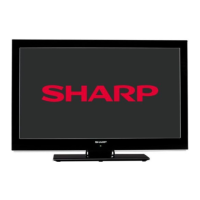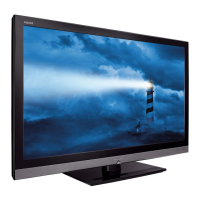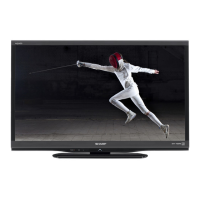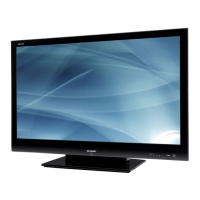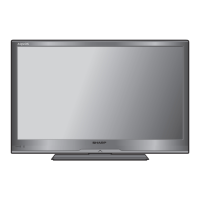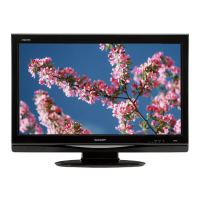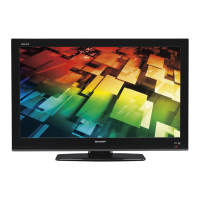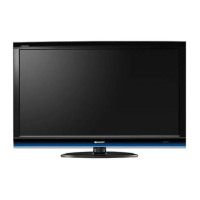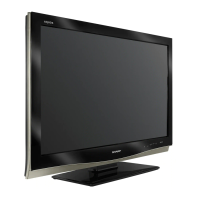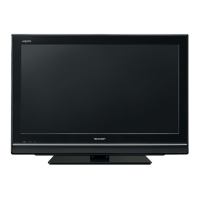Do you have a question about the Sharp Aquos LC-32L400X and is the answer not in the manual?
Safe cleaning methods and warnings against water exposure.
Guidelines for stable placement and avoiding overturning hazards.
Ensuring proper airflow and keeping TV away from heat sources.
Tips to prevent fire hazards and safe AC cord handling.
Precautions for LCD panel care and safe transportation.
Additional warnings regarding heavy objects, children, and static picture display.
Information on energy-saving status for household use.
Mentions of registered trademarks like HDMI, Dolby, and ENERGY STAR.
Step-by-step guide to safely attach the television stand.
Instructions for connecting an antenna for clearer picture reception.
How to connect VCRs, game consoles, or camcorders using input terminals.
Guide for connecting DVD players or digital set-top boxes via HDMI or component.
Instructions for connecting a personal computer to the TV.
Information on outputting audio through the digital audio output terminal.
Detailed explanation of the television's remote control buttons and functions.
Step-by-step guide for inserting batteries into the remote control.
Identification of all physical parts and connection terminals on the TV.
Guidelines and notes for using the TV's headphone jack.
Instructions for operating the TV's power and standby modes.
Procedure to enable or disable power supply to the antenna.
Guide through the initial setup wizard for channels and settings.
How to check signal strength and quality for antenna alignment.
Understanding signal strength and quality values for optimal antenna alignment.
Steps to perform auto installation again after initial setup.
Configuring digital TV settings, including auto search and manual adjustments.
Sorting programme positions and adjusting analogue TV settings.
Detailed manual adjustments for analogue channels like search, fine-tuning, and colour systems.
How to sort and erase analogue TV programmes.
Choosing viewing options to match environment or input source.
General instructions for operating the TV's menu system.
Comprehensive guide to adjusting picture quality, contrast, brightness, and colour.
Fine-tuning colour temperature and using film mode for picture enhancement.
Settings for treble, bass, balance, and surround sound options.
Managing power consumption with features like auto power-off and ecology mode.
Setting up a password to protect TV settings from unauthorized changes.
Restricting channels by age and assigning custom labels to input sources.
Adjusting picture position, auto HDMI view, WSS, and skipping input sources.
Configuring screen aspect ratio, TV startup speed, and Teletext language.
Selecting input sources, PC audio, auto volume, and digital audio output formats.
Options for audio-only mode, game timer, colour system, and software version.
Guides for optimizing PC input image quality via manual or auto sync.
Selecting audio and subtitle languages, including for hearing impaired.
Setting local time zone, summer time, and enabling automatic software downloads.
How to view and browse the electronic programme guide.
Scheduling reminders for future TV programmes.
Information displayed on the general info screen for current programmes.
Using buttons to switch between ATV, DTV, RADIO modes and initial auto installation.
Changing audio formats for stereo, bilingual, and monaural broadcasts.
Further details on selecting stereo, bilingual, and monaural audio formats.
Options for automatically or manually adjusting the picture size and aspect ratio.
Viewing and cancelling scheduled programme reminders in the EPG.
How to freeze a motion picture on the display or exit the mode.
Selecting various picture sizes like Normal, Zoom, Panorama, Full, Cinema, and Underscan.
How to turn Teletext on/off and use its various button functions.
Details on RS-232C communication, commands, and parameters for PC control.
Chart detailing compatible PC resolutions and frequencies for analogue and digital inputs.
Comprehensive list of commands for controlling the TV via RS-232C interface.
Solutions for common issues like no power, no picture, or sound problems.
Guidance on using the TV in different temperature environments and storage.
Steps to clear a forgotten password for child lock or other settings.
Safety measures to anchor the TV to a wall or table to prevent overturning.
Diagrams showing the overall dimensions of the television.
Instructions to set a new password after clearing the old one.
Safe cleaning methods and warnings against water exposure.
Guidelines for stable placement and avoiding overturning hazards.
Ensuring proper airflow and keeping TV away from heat sources.
Tips to prevent fire hazards and safe AC cord handling.
Precautions for LCD panel care and safe transportation.
Additional warnings regarding heavy objects, children, and static picture display.
Information on energy-saving status for household use.
Mentions of registered trademarks like HDMI, Dolby, and ENERGY STAR.
Step-by-step guide to safely attach the television stand.
Instructions for connecting an antenna for clearer picture reception.
How to connect VCRs, game consoles, or camcorders using input terminals.
Guide for connecting DVD players or digital set-top boxes via HDMI or component.
Instructions for connecting a personal computer to the TV.
Information on outputting audio through the digital audio output terminal.
Detailed explanation of the television's remote control buttons and functions.
Step-by-step guide for inserting batteries into the remote control.
Identification of all physical parts and connection terminals on the TV.
Guidelines and notes for using the TV's headphone jack.
Instructions for operating the TV's power and standby modes.
Procedure to enable or disable power supply to the antenna.
Guide through the initial setup wizard for channels and settings.
How to check signal strength and quality for antenna alignment.
Understanding signal strength and quality values for optimal antenna alignment.
Steps to perform auto installation again after initial setup.
Configuring digital TV settings, including auto search and manual adjustments.
Sorting programme positions and adjusting analogue TV settings.
Detailed manual adjustments for analogue channels like search, fine-tuning, and colour systems.
How to sort and erase analogue TV programmes.
Choosing viewing options to match environment or input source.
General instructions for operating the TV's menu system.
Comprehensive guide to adjusting picture quality, contrast, brightness, and colour.
Fine-tuning colour temperature and using film mode for picture enhancement.
Settings for treble, bass, balance, and surround sound options.
Managing power consumption with features like auto power-off and ecology mode.
Setting up a password to protect TV settings from unauthorized changes.
Restricting channels by age and assigning custom labels to input sources.
Adjusting picture position, auto HDMI view, WSS, and skipping input sources.
Configuring screen aspect ratio, TV startup speed, and Teletext language.
Selecting input sources, PC audio, auto volume, and digital audio output formats.
Options for audio-only mode, game timer, colour system, and software version.
Guides for optimizing PC input image quality via manual or auto sync.
Selecting audio and subtitle languages, including for hearing impaired.
Setting local time zone, summer time, and enabling automatic software downloads.
How to view and browse the electronic programme guide.
Scheduling reminders for future TV programmes.
Information displayed on the general info screen for current programmes.
Using buttons to switch between ATV, DTV, RADIO modes and initial auto installation.
Changing audio formats for stereo, bilingual, and monaural broadcasts.
Further details on selecting stereo, bilingual, and monaural audio formats.
Options for automatically or manually adjusting the picture size and aspect ratio.
Viewing and cancelling scheduled programme reminders in the EPG.
How to freeze a motion picture on the display or exit the mode.
Selecting various picture sizes like Normal, Zoom, Panorama, Full, Cinema, and Underscan.
How to turn Teletext on/off and use its various button functions.
Details on RS-232C communication, commands, and parameters for PC control.
Chart detailing compatible PC resolutions and frequencies for analogue and digital inputs.
Comprehensive list of commands for controlling the TV via RS-232C interface.
Solutions for common issues like no power, no picture, or sound problems.
Guidance on using the TV in different temperature environments and storage.
Steps to clear a forgotten password for child lock or other settings.
Safety measures to anchor the TV to a wall or table to prevent overturning.
Diagrams showing the overall dimensions of the television.
Instructions to set a new password after clearing the old one.
